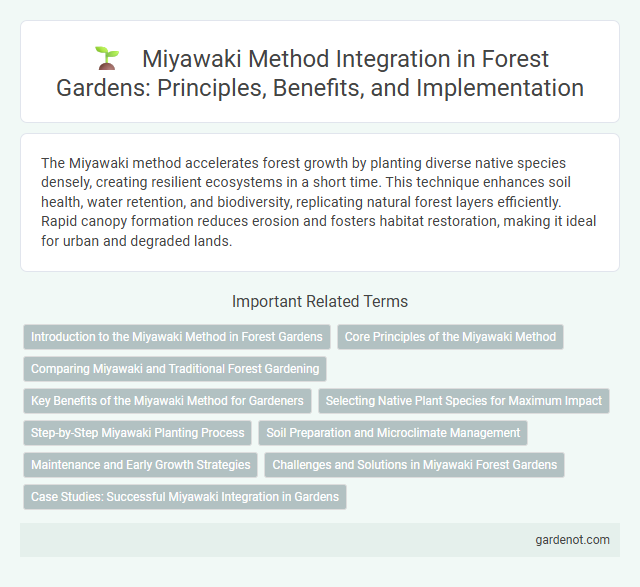The Miyawaki method accelerates forest growth by planting diverse native species densely, creating resilient ecosystems in a short time. This technique enhances soil health, water retention, and biodiversity, replicating natural forest layers efficiently. Rapid canopy formation reduces erosion and fosters habitat restoration, making it ideal for urban and degraded lands.
Introduction to the Miyawaki Method in Forest Gardens
The Miyawaki Method accelerates forest restoration by planting native tree species densely to mimic natural forests, fostering rapid growth and biodiversity in forest gardens. This technique enhances soil quality and microclimate, creating self-sustaining ecosystems within a few years. Implementing the Miyawaki Method transforms degraded lands into thriving, resilient forest gardens that support local wildlife and improve ecological balance.
Core Principles of the Miyawaki Method
The Miyawaki Method emphasizes planting native species densely to mimic natural forest structures, fostering biodiversity and accelerating growth. This technique relies on deep soil preparation to enhance microbial activity and root development, crucial for sustainable forest ecosystems. Key principles also include selecting resilient species adapted to local climates and ensuring layered vegetation for ecological balance and habitat creation.
Comparing Miyawaki and Traditional Forest Gardening
The Miyawaki method accelerates forest garden growth by planting dense native species clusters to achieve mature biodiversity in 20-30 years, contrasting with traditional forest gardening's spaced, multi-layered planting over decades. Unlike conventional practices that prioritize food production and gradual succession, Miyawaki focuses on rapid ecological restoration and resilience through species diversity. Both methods enhance ecosystem services, but Miyawaki delivers faster canopy development and soil revitalization due to its intensive initial planting design.
Key Benefits of the Miyawaki Method for Gardeners
The Miyawaki method accelerates forest garden growth by planting native species densely, resulting in rapid biodiversity restoration within 20-30 years compared to traditional reforestation. This technique enhances soil fertility and water retention through complex root networks, reducing gardeners' maintenance efforts and increasing ecosystem resilience. Gardeners benefit from improved air quality, habitat creation for pollinators, and natural carbon sequestration that supports sustainable urban greening projects.
Selecting Native Plant Species for Maximum Impact
Selecting native plant species in the Miyawaki method ensures rapid forest growth and biodiversity restoration, as these species are well-adapted to local soil, climate, and ecological conditions. This approach promotes a self-sustaining ecosystem by enhancing soil fertility and supporting native wildlife, accelerating canopy formation within 20 to 30 years. Prioritizing indigenous plants maximizes carbon sequestration and resilience against pests and diseases, making the forest garden both productive and sustainable.
Step-by-Step Miyawaki Planting Process
The Miyawaki planting process begins with analyzing the native forest ecosystem to select indigenous species that promote biodiversity. Soil preparation involves layering organic compost and mulch to enhance microbial activity and moisture retention. Seedlings are densely planted in a randomized pattern, ensuring rapid growth and natural forest development within 2 to 3 years.
Soil Preparation and Microclimate Management
The Miyawaki method emphasizes enriching soil with organic compost and biochar to enhance microbial activity and nutrient availability for rapid forest growth. Soil preparation involves deep loosening and layering of fertile, well-drained substrates to support diverse native species. Microclimate management includes creating windbreaks and optimizing shade levels to maintain moisture and temperature stability essential for seedling establishment.
Maintenance and Early Growth Strategies
The Miyawaki method emphasizes dense planting of native species to accelerate forest garden growth while minimizing maintenance efforts. Early growth strategies include vigorous soil preparation with organic matter and mulching to retain moisture and suppress weeds, promoting rapid seedling establishment. Regular monitoring for pests and selective pruning in the initial years ensures healthy development and maximizes biodiversity.
Challenges and Solutions in Miyawaki Forest Gardens
Challenges in the Miyawaki method include initial high labor intensity and the need for native species expertise to ensure biodiversity and ecosystem balance. Solutions involve community engagement to reduce labor costs and collaboration with local botanists for accurate species selection. Ongoing monitoring and adaptive management further address growth irregularities and environmental stressors in Miyawaki forest gardens.
Case Studies: Successful Miyawaki Integration in Gardens
The Miyawaki method has been successfully implemented in urban forest gardens across various regions, demonstrating rapid biodiversity growth and increased canopy density within a few years. Case studies from India and Japan reveal native species thriving due to dense planting techniques and minimal maintenance, resulting in ecosystems that support local wildlife and improve air quality. These forest gardens showcase the method's potential for restoring degraded lands and creating sustainable green spaces in urban environments.
Miyawaki method Infographic

 gardenot.com
gardenot.com